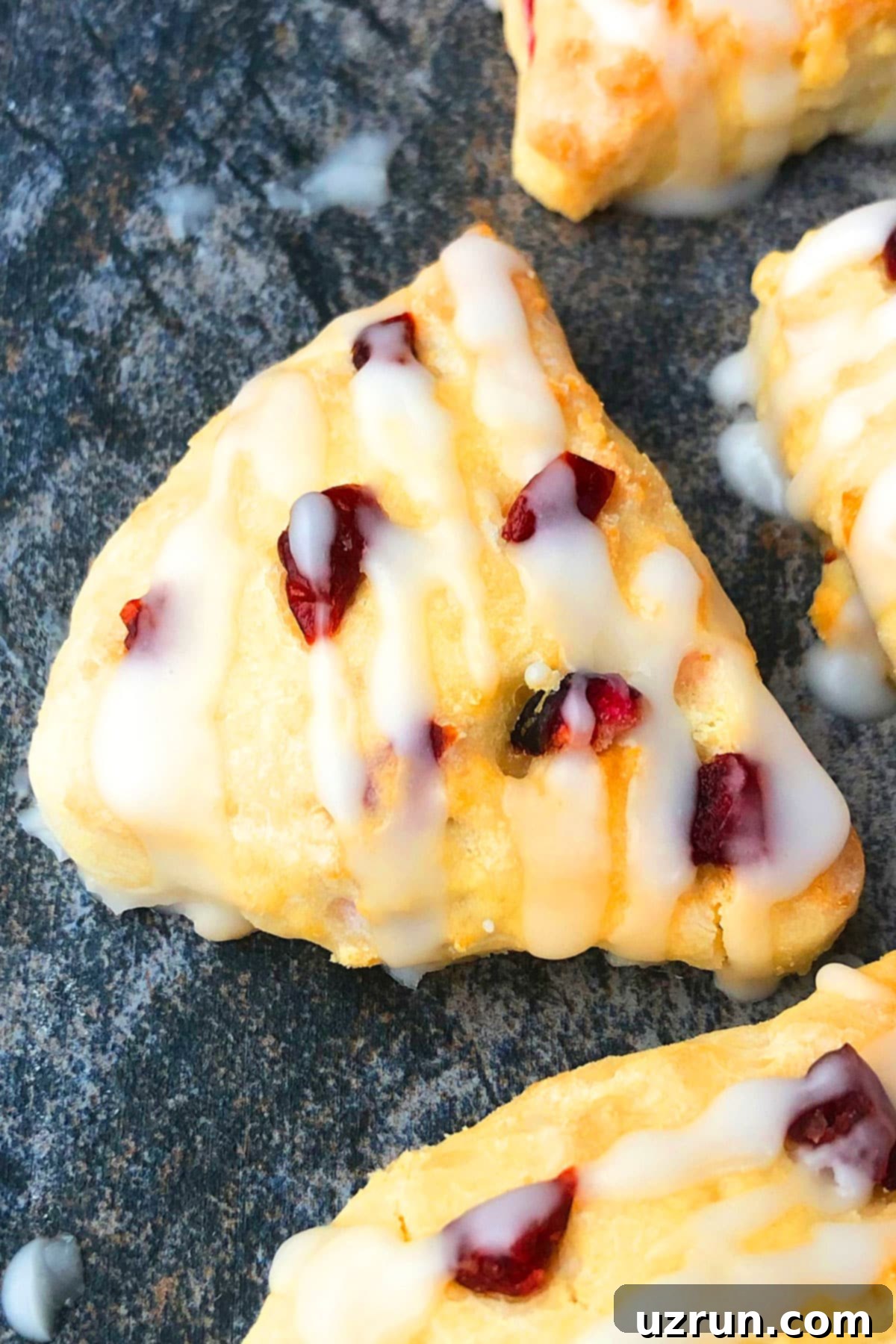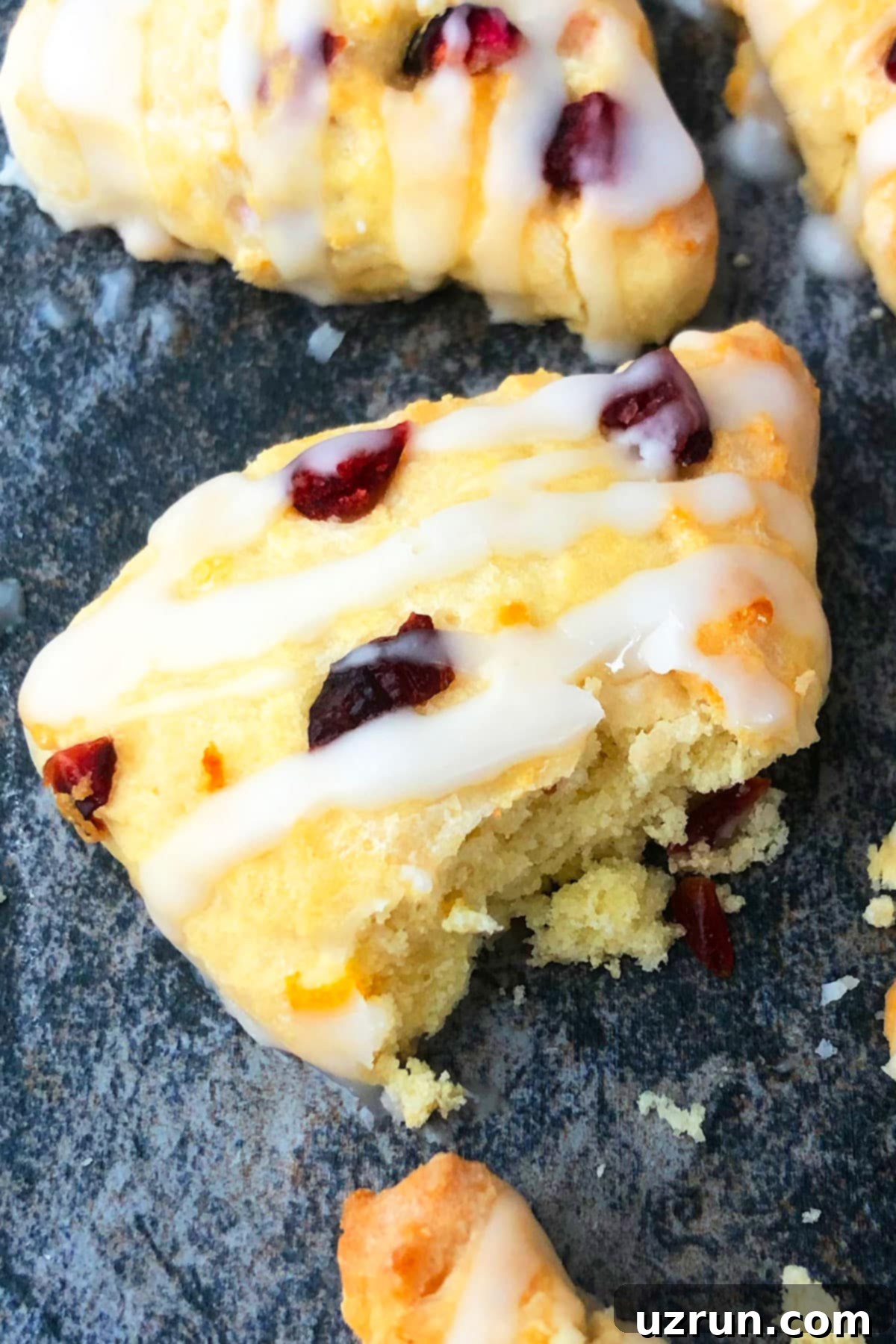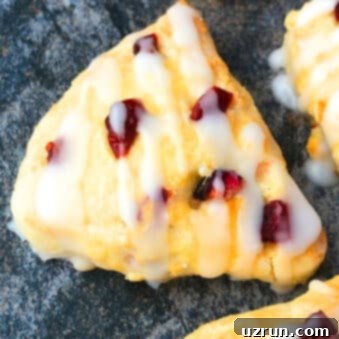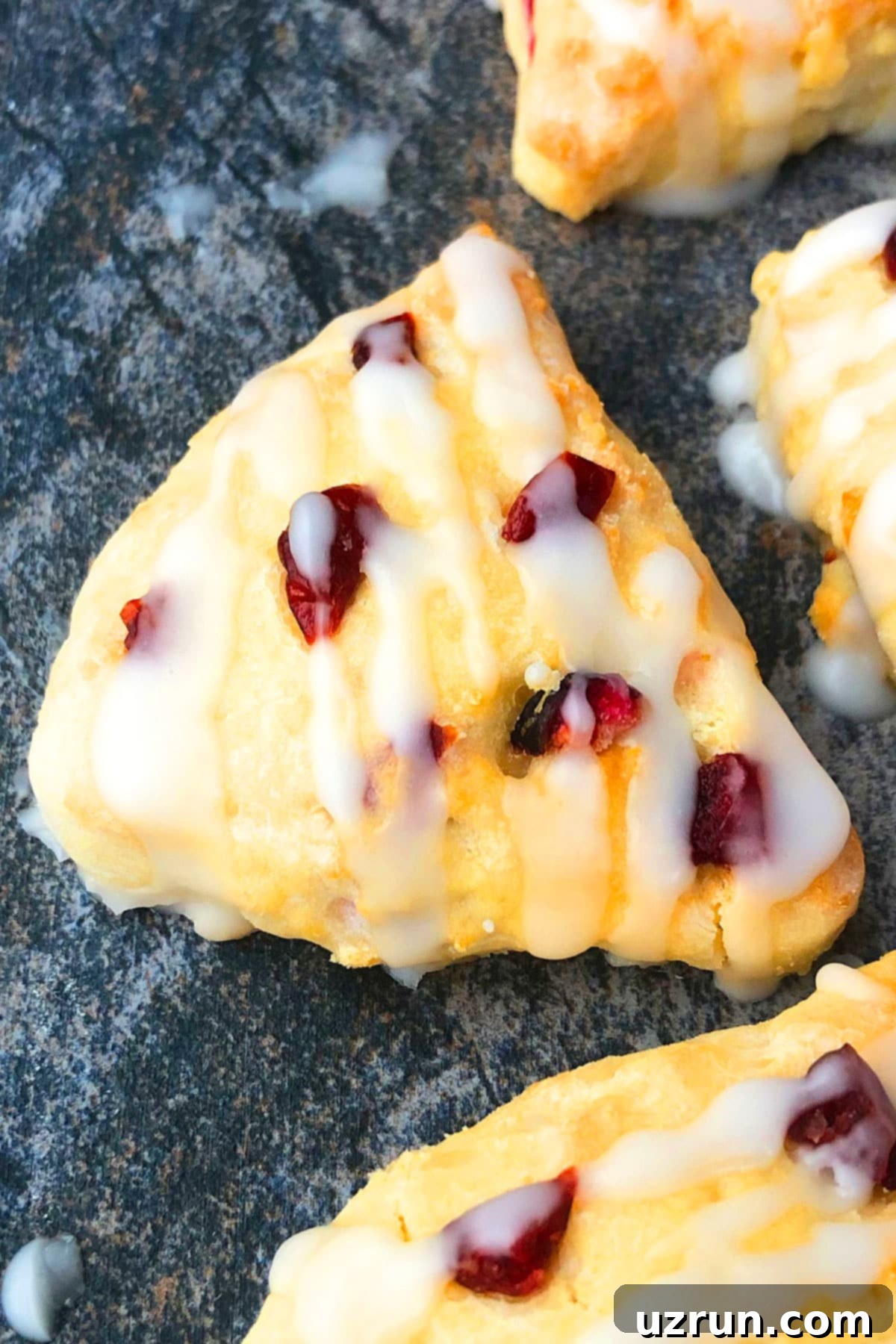Easy Cranberry Orange Scones: The Ultimate Homemade Recipe with Zesty Orange Glaze
Indulge in the delightful world of homemade baking with this quick and easy cranberry orange scones recipe. These scones are a true treat, featuring a light, moist, and subtly crumbly texture that perfectly balances the sweet and tart flavors of dried cranberries and bright orange zest, all finished with a luscious orange glaze. Crafted from simple, readily available ingredients, these scones bring a touch of bakery-quality goodness right into your kitchen. Whether you’re a seasoned baker or just starting, this recipe is designed to be straightforward, delivering consistently delicious results every time. While dried cranberries are excellent here, feel free to experiment with fresh cranberries for an added burst of juiciness and vibrant color.

These cranberry orange scones are an absolutely brilliant addition to your morning coffee routine, transforming an ordinary start into a special occasion. Beyond daily indulgence, they truly deserve a prominent spot on your baking list, especially as the Christmas holidays approach. The festive flavors of cranberry and orange are synonymous with holiday cheer, making these scones a perfect treat for gatherings, brunches, or simply enjoying by the fireplace. If you adore the combination of cranberries in your desserts, you’ll undoubtedly savor these just as much as some of these other delightful cranberry-infused recipes:
- Christmas Cranberry Cake
- Fresh Cranberry Cookies (With White Chocolate, Orange, Oatmeal)
- Sugared Cranberries
- Cranberry Orange Muffins
Table of Contents
- What are Scones? What Do They Taste Like?
- The Magic of Cranberry and Orange
- Key Ingredients for Perfect Scones
- Exciting Variations to Try
- How to Make the Best Easy Cranberry Orange Scones from Scratch
- Essential Tips and Techniques for Scone Success
- Recipe FAQs
- Storage and Make-Ahead Options
- More Festive Christmas Desserts
What are Scones? What Do They Taste Like?
Scones are a beloved British pastry, often described as a cross between a biscuit and a cake, offering a unique and delightful eating experience. They boast a distinct texture that is simultaneously crumbly, light, and tender, a result of precise ingredient ratios and careful handling. Traditionally, scones are made with wheat or oatmeal flour and often include fruit, such as raisins, currants, or in this case, cranberries. Originating from Great Britain, scones are an indispensable component of the quintessential “cream tea” or afternoon tea, served alongside clotted cream and jam. However, they are equally at home at high tea or as a simple, comforting accompaniment to a cup of coffee.
While available in a variety of different flavors, scones are predominantly sweet and fruity. Their mild sweetness is often complemented by the addition of berries or other fruits, providing a natural tang or richness. The beauty of a scone lies in its versatility, as it serves as a perfect canvas for various toppings. Common accompaniments include a delicate sugar glaze, rich Strawberry Jam, a drizzle of golden honey, or a simple spread of creamy butter. Our cranberry orange scones perfectly embody this tradition, offering a vibrant flavor profile that is both classic and refreshing.
A frequent question arises about the difference between scones and biscuits. While they share some similarities in appearance and leavening agents, key distinctions exist. Scones typically incorporate eggs, which contribute to their slightly richer, more cake-like crumb compared to the flakier, often savory biscuit. Biscuits are usually round and served alongside hearty meals with gravy, whereas scones are often triangular, sweeter, and enjoyed as a pastry or dessert.
The Magic of Cranberry and Orange
The combination of cranberry and orange is a culinary classic for a reason, especially during the colder months and holiday season. Cranberries, with their characteristic tartness, provide a delightful contrast to the sweet undertones of the scone dough. This tartness cuts through richness, invigorating the palate and preventing the scone from being overly sweet. Paired with the bright, aromatic citrus notes of orange zest and juice, the flavor profile becomes incredibly well-rounded and complex. The orange introduces a fragrant, sunny element that complements the cranberries beautifully, creating a harmonious balance that is both comforting and exhilarating. This dynamic duo makes these scones not just a simple pastry, but a truly memorable taste experience.
Key Ingredients for Perfect Scones
Crafting the perfect scone relies on understanding the role of each ingredient. Here’s a breakdown of the essential components for these delicious cranberry orange scones:
- All-Purpose Flour: This forms the foundational structure of your scones. Using good quality all-purpose flour ensures a tender crumb. Avoid using self-rising flour, as it contains leavening agents that might interfere with the controlled rise from your baking powder.
- Baking Powder: A crucial leavening agent, baking powder is responsible for giving the scones their signature fluffy, light rise. It reacts when mixed with wet ingredients and heat, creating air pockets that result in that delightful airy texture.
- Granulated Sugar: Beyond adding essential sweetness, sugar also contributes to the tender texture of the scones. It interacts with other ingredients to keep the dough from becoming tough, while also caramelizing slightly during baking for a beautiful golden hue.
- Cold Unsalted Butter: This is perhaps the most critical ingredient for flaky, crumbly scones. The butter must be kept very cold and cut into small pieces. When mixed into the flour, these cold butter pieces create pockets. As the scones bake, the butter melts, releasing steam and creating layers, resulting in that desirable light and airy texture. Using unsalted butter allows you to control the overall saltiness of the recipe.
- Dried Cranberries: These provide bursts of sweet-tart flavor and a chewy texture. Ensure they are roughly chopped, rather than left whole. Chopping prevents them from sinking to the bottom of the dough and ensures an even distribution of flavor throughout each scone.
- Cold Large Eggs: While many baking recipes call for room temperature eggs, cold eggs are preferred here. They help keep the overall dough temperature low, which is vital for maintaining the coldness of the butter. Eggs also add richness, moisture, and contribute to the structural integrity of the scones.
- Cold Half and Half: This rich dairy product provides essential moisture and a luxurious creaminess to the scone dough. Its higher fat content compared to milk is key to achieving a truly moist and tender scone. Do not substitute with milk, as the lower fat content will result in a less rich and potentially drier scone.
- Orange Zest: The secret to the bright, intense orange flavor in these scones. The zest contains concentrated citrus oils, which infuse the dough with a vibrant aroma and taste without adding excess liquid.
- Powdered Sugar: This fine sugar is the base for our exquisite orange glaze. Its smooth texture ensures a lump-free, silky glaze that beautifully coats the baked scones.
- Orange Juice: Used in the glaze, fresh orange juice adds an extra layer of citrus tang and helps create the perfect pourable consistency for the powdered sugar, enhancing the overall orange flavor profile.
Exciting Variations to Try
This cranberry orange scone recipe is wonderfully adaptable! Feel free to customize it with these exciting variations:
- Add chocolate chips: Introduce a delightful richness by folding in semisweet, dark, milk, or white chocolate chips. The cranberry and white chocolate combination is particularly phenomenal, offering a sweet and tart harmony that is irresistible.
- Try other berries: Experiment with different fruit additions to change the flavor profile. Raspberries offer a sharp tang, blackberries a deeper sweetness, blueberries a classic scone flavor, or even chopped apples or cherries for seasonal appeal. Raisins are also a traditional scone addition.
- Add other flavors, extracts, and zests: Elevate the aroma and taste with various extracts or zests. Lemon zest or lime zest can provide a different citrus twist, while almond extract or coconut extract can introduce unique nutty or tropical undertones.
- Add a different flavored glaze: Customize your topping to suit your preference. A simple Powdered Sugar Glaze (Vanilla Cake Glaze) offers a classic sweetness, or a vibrant Lemon Glaze can enhance the citrus notes with a zesty kick.
- Diverse topping options: Beyond glaze, consider other delicious toppings. Apple Butter, a dollop of Lemon Curd, a delicate drizzle of melted chocolate, sparkling sugar for an added crunch and shimmer, or a cloud of Homemade Whipped Cream are some fantastic choices to serve alongside.
- Use a combination of fresh and dried cranberries: While this recipe primarily uses dried cranberries for convenience and concentrated flavor, incorporating both fresh and dried cranberries can add a wonderful textural contrast, an extra burst of juicy tartness, and a stunning visual appeal with varied shades of red.
- Use cookie cutters: For holidays and special occasions, get creative with your scone shapes. Heart, star, circle, or square cookie cutters can transform simple scones into festive treats, perfect for celebrations.
- Serve alongside warm holiday beverages: Enhance the cozy factor by pairing these scones with comforting drinks. Consider Homemade Eggnog, an Eggnog Latte, a creamy White Hot Chocolate, or a refreshing Peppermint White Chocolate Mocha for the ultimate festive experience.
- Use buttermilk: For a slightly tangier flavor and often a very tender crumb, some bakers prefer to substitute buttermilk for half and half. While I haven’t personally tested this specific adaptation with this recipe, many readers have reported excellent results when making this substitution in similar scone recipes.
How to Make the Best Easy Cranberry Orange Scones from Scratch
Creating these perfect homemade cranberry orange scones is a straightforward process when you follow these simple steps:
- Prepare Dry Ingredients: In a spacious mixing bowl, meticulously whisk together the all-purpose flour, baking powder, and granulated sugar. Whisking thoroughly ensures that the leavening agent is evenly distributed, leading to a consistent rise in every scone.
- Incorporate Cold Butter: Add the small, cold pieces of unsalted butter to the dry mixture. Using a pastry cutter or a fork, work the butter into the flour until the mixture resembles coarse crumbs with some pea-sized pieces of butter remaining. This step is crucial for creating those coveted flaky layers in your scones.
- Fold in Cranberries: Gently stir in the roughly chopped dried cranberries. Mix just until they are evenly distributed throughout the crumbly mixture. Avoid overmixing at this stage.
- Combine Wet Ingredients: In a separate bowl, whisk together the cold large egg, cold half and half, and aromatic orange zest until well combined. The cold temperature of these ingredients is key to preventing the butter from melting prematurely.
- Merge Wet and Dry: Pour the wet egg mixture into the dry crumbly mixture. Using a fork or your hands, mix until a rough, shaggy ball of dough forms. The goal is to just bring the ingredients together, not to develop the gluten.
- Shape the Dough: Turn the dough out onto a lightly floured surface. Briefly knead it just enough to bring it into a cohesive ball. Divide this ball into two equal parts. Roll out each portion into a thick, flat circle, approximately ¾ inch thick.
- Cut into Triangles: Using a sharp knife or a pastry cutter, cut each circle into 8 triangular slices. This traditional scone shape is both appealing and easy to manage.
- Bake to Golden Perfection: Arrange the scone triangles on a baking tray lined with parchment paper. Bake in a preheated oven at 425°F (220°C) for about 10-12 minutes, or until the tops are beautifully golden brown and the scones are cooked through.
- Cool and Glaze: Allow the baked scones to cool completely on a wire rack. Once cooled, prepare the orange glaze by mixing powdered sugar, orange juice, and orange zest. Drizzle generously over the cooled scones and, if desired, sprinkle with extra chopped cranberries for a decorative and flavorful finish. Let the glaze set before serving.

Essential Tips and Techniques for Scone Success
Achieving light, flaky, and flavorful scones is an art, but one that is easily mastered with a few key tips and techniques:
- Always Use Cold Ingredients: This is arguably the most crucial tip for perfect scones. Ensure your butter, eggs, and half and half are thoroughly chilled. Cold ingredients prevent the butter from melting into the flour before baking. When cold butter hits the hot oven, it creates steam, which is what gives scones their wonderful pockets and flaky layers. If your dough becomes too sticky during handling, it’s likely that your ingredients (especially the butter) have warmed up.
- Opt for Unsalted Butter: Using unsalted butter gives you precise control over the salt content in your recipe. Different brands of salted butter can vary widely in their sodium levels, which could unintentionally make your scones too salty or alter the flavor balance.
- Adjust Scone Size for Your Preference: This recipe yields mini-sized scones, which are incredibly charming and easy to eat, perfect for serving a crowd or as a small treat. If you prefer larger, regular-sized scones, simply do not divide the dough into two parts. Roll out the entire dough portion into one thick circle and cut it into 8 slices. The baking time might need to be extended slightly, so keep an eye on their golden-brown color.
- Scale the Recipe for Any Gathering: This recipe is easily adaptable to feed more people. You can effortlessly double or triple the ingredients to serve a large crowd for a brunch, party, or holiday feast. The more the merrier when it comes to delicious homemade scones!
- Do Not Overmix the Dough: Overmixing is the enemy of tender scones. When flour and liquid are combined and worked excessively, gluten develops, leading to a tough, chewy texture rather than the desired light and crumbly one. Work the dough gently and quickly, bringing it together with a light hand until just combined. If the dough feels too sticky, a minimal sprinkle of extra flour on your hands and the work surface will help prevent sticking without overworking the dough.
- Grate Your Butter for Easier Incorporation: For an even distribution of cold butter and a finer crumb, consider grating your frozen or very cold butter using a box grater. This technique creates tiny shards of butter that mix effortlessly into the flour, resulting in wonderfully tender and flaky scones.
- Chill the Dough Before Baking: After shaping your scones, place them on the baking sheet and pop them in the refrigerator for 15-30 minutes before baking. This extra chilling step helps firm up the butter again, ensuring maximum steam production and a better rise in the oven.
- Use a Hot Oven: Scones benefit from a high initial baking temperature. The intense heat causes the butter to melt rapidly and create steam, leading to a quick and dramatic rise and a beautifully golden crust.
- Avoid Opening the Oven Door: Resist the urge to open the oven door during the first two-thirds of the baking time. This allows the heat to remain consistent, promoting an even rise and preventing the scones from collapsing.

Recipe FAQs
The most prominent difference between scones and biscuits lies in their ingredients and typical serving. Scones traditionally contain eggs, which contribute to a richer, slightly more cake-like and tender crumb. They are also generally sweeter and are a staple of British tea traditions, often served with jam and cream as a dessert or afternoon treat. Biscuits, on the other hand, typically do not contain eggs, resulting in a flakier, often layered texture. They tend to be less sweet or even savory, and in American cuisine, are commonly served as a side dish with gravies or other savory accompaniments. Additionally, traditional scones are often cut into triangular wedges, while biscuits are typically round.
Several factors can contribute to flat scones that don’t rise properly. The most common culprit is often the butter not being cold enough. Cold butter is essential because when it melts in the hot oven, it releases steam, which creates pockets and gives the scones their lift and flaky texture. If the butter is too soft or warm when incorporated into the dough, it melts prematurely, preventing this crucial steam production. Another reason could be rolling the dough too thin; scones need a certain thickness (around ¾ inch) to achieve a good rise. Overworking the dough can also lead to flat scones, as it develops gluten, making the dough tough and inhibiting its ability to rise. Ensure your baking powder is fresh and active, as expired leavening agents will also result in poor rise.
Yes, you absolutely can use fresh cranberries in this recipe with excellent results! Fresh cranberries will add a wonderful juiciness and an intense burst of tartness, along with a vibrant red color, which can be a delightful addition. They integrate seamlessly into the dough. However, it is generally not recommended to use frozen cranberries directly from the freezer or after thawing. Frozen cranberries tend to release a significant amount of moisture upon thawing, which can alter the dough’s consistency and make it too wet. If you only have frozen cranberries, it’s best to thaw them completely, drain any excess liquid, and then pat them very dry before adding them to the dough, treating them much like fresh cranberries.
The secret to incredibly moist scones lies primarily in a few key ingredients and proper baking technique. Firstly, high-fat dairy products like butter and half and half (or heavy cream) are essential. Their rich fat content contributes significantly to the scones’ tenderness and moisture. Secondly, eggs play a vital role, adding both moisture and richness to the dough. Beyond ingredients, the most critical technique is to avoid over-baking. Scones should be baked until just golden brown and cooked through. Over-baking them, even by a few minutes, will inevitably dry them out and compromise their delicate, moist texture. Using cold ingredients and not overmixing the dough also contributes to maintaining moisture by preventing gluten overdevelopment and allowing the butter to create steam, resulting in a light, tender crumb.
Storage and Make-Ahead Options
These cranberry orange scones are best enjoyed fresh, but they store remarkably well, allowing you to prepare them in advance or save leftovers for later enjoyment.
- Make Ahead: To simplify your morning routine, these scones can be baked up to 1 day in advance. Once cooled, store them in an airtight container at room temperature or in the fridge. For optimal freshness, glaze them just before serving. You can also prepare the scone dough, shape it, and freeze the unbaked scones. Simply place the cut scones on a baking sheet and freeze until solid, then transfer to a freezer-safe bag for up to 1 month. Bake from frozen, adding a few extra minutes to the baking time.
- Room Temperature: Un-glazed scones can be stored in an airtight container at room temperature for up to 3 days. If glazed, store them for no more than 1-2 days at room temperature to prevent the glaze from becoming too sticky.
- Refrigerate: For longer storage, place baked scones (glazed or un-glazed) in a sealed container and keep them in the refrigerator for up to 5 days. Reheat gently in a microwave or oven for a few minutes before serving.
- Freezer: For extended freshness, baked and fully cooled scones can be frozen. Place them in a single layer on a baking sheet to freeze solid, then transfer them to a freezer-safe airtight container or bag. They will keep well for up to 1 month. Thaw frozen scones overnight in the refrigerator or reheat directly from frozen in a moderate oven until warmed through. This is perfect for having a delicious treat on hand whenever a craving strikes!
More Festive Christmas Desserts
If you’re looking to expand your holiday baking repertoire, these festive Christmas desserts are sure to be a hit with family and friends. They perfectly complement the flavors and spirit of the season:
- Jam Thumbprint Cookies
- White Chocolate Bark
- White Chocolate Peppermint Cookies
- Snickerdoodle Cookies
- Red Velvet Crinkle Cookies
Recipe

Easy Cranberry Orange Scones
Abeer Rizvi
Pin Recipe
10 minutes
15 minutes
25 minutes
Breakfast, Dessert
American, British
16
Scones (Mini size)
180
kcal
Want to Save This Recipe?
Enter your email & I’ll send it to your inbox. Plus, get great new recipes from me every week!
By submitting this form, you consent to receive emails from CakeWhiz
Ingredients
Scones
-
2
cups
All-purpose flour -
1.5
teaspoon
Baking powder -
⅓
cup
Granulated sugar -
½
cup
Butter
Unsalted, Cold, Cut into small pieces -
½
cup
Dried cranberries
Roughly chopped -
1
Egg
Large, Cold -
½
cup
Half and half
Or heavy cream, Cold -
2
tablespoon
Orange zest -
¼
cup
Additional dried cranberries
Roughly chopped, For garnish, Optional
Orange Glaze
-
1
cup
Powdered sugar -
2
tablespoon
Orange juice -
1
teaspoon
Orange zest
Instructions
-
In a large mixing bowl, whisk together the flour, baking powder and sugar.
-
Add cold butter pieces and use a pastry cutter (or a fork) to mix the butter roughly into the flour mixture until it becomes crumbly, with some pea-sized pieces of butter still visible.
-
Gently stir in the chopped dried cranberries until just combined. Keep aside.
-
In another mixing bowl, whisk together the cold egg, cold half and half, and fragrant orange zest until thoroughly blended.
-
Pour this wet egg mixture into the dry crumbled mixture and mix it together with a fork or your hands until it is just roughly combined and forms a shaggy dough. Avoid overmixing.
-
Turn this mixture onto a lightly floured surface.
-
Flour your hands lightly and work the dough gently, bringing everything together into a cohesive ball. Remember, do not over-work the dough! If the dough is too sticky, sprinkle some extra flour on top and on your hands to prevent it from sticking to your hands and the surface.
-
Divide the dough into 2 equal parts.
-
Roll out each portion into a flat circle, about ¾ inch thick. This thickness is ideal for a good rise.
-
Cut each circle into 8 triangle slices using a sharp knife or pastry wheel.
-
Place them onto a baking tray that has been lined with parchment paper, leaving a little space between each scone.
-
Bake in a preheated oven at 425 degrees F (220°C) for approximately 10-12 minutes, or until the scones are beautifully golden brown on top and cooked through.
-
Allow the baked scones to cool down completely on a wire rack before glazing. This prevents the glaze from melting.
-
While the scones are baking and cooling, prepare the vibrant orange glaze. In a small mixing bowl, whisk together the powdered sugar, fresh orange juice, and a touch of orange zest until you achieve a smooth, pourable consistency.
-
Once the scones are fully cooled, generously drizzle them with the prepared orange glaze. For an extra touch of beauty and flavor, sprinkle with additional chopped cranberries, if desired.
-
Allow the glaze to set for a few minutes before serving to prevent messiness. Then, savor every delicious bite!
Notes
- Always use cold ingredients (butter, eggs, half and half) to prevent the dough from becoming too sticky and to ensure that perfect, light, and crumbly texture in your scones. The cold butter creates steam for lift.
- Do not over-work the dough! Mixing too much develops gluten, which makes scones tough instead of tender. If the dough is too sticky, sprinkle some extra flour on top and on your hands to prevent sticking to your hands and to the surface, but still handle minimally.
- For the richest flavor and best texture, use full-fat ingredients for the half and half (or heavy cream) and butter.
- It’s essential to not glaze the scones until they have fully cooled to room temperature. Applying glaze to warm scones will cause it to melt and run off, resulting in a soggy scone and a thin, uneven coating.
- For a delightful twist, consider using lemon zest instead of orange zest in both the scones and the glaze. This will create a different, yet equally delicious, bright citrus flavor profile.
- For more detailed insights, creative ideas, and troubleshooting advice, be sure to read the additional tips and variations provided above in the main article.
- Leftovers can be stored in a sealed airtight container in the refrigerator for up to 5 days. Alternatively, they can be stored in a sealed container at room temperature for up to 3 days. For longer storage, baked and cooled scones can be frozen in an airtight container for up to 1 month. Thaw frozen scones overnight in the fridge or reheat gently in an oven.
Nutrition
Calories:
180
kcal
Carbohydrates:
27
g
Protein:
2
g
Fat:
7
g
Saturated Fat:
4
g
Cholesterol:
28
mg
Sodium:
58
mg
Potassium:
81
mg
Sugar:
14
g
Vitamin A:
225
IU
Vitamin C:
2.3
mg
Calcium:
35
mg
Iron:
0.8
mg
An automated tool is used to calculate the nutritional information. As such, I cannot guarantee the accuracy of the nutritional information provided for any recipe on this site.
Tried this recipe?
Leave a comment below or rate and tag @cakewhiz on social
